KSysGuard/zh-cn: Difference between revisions
m (Created page with "'''系统监视器(KSysGuard)'''设计成无需使用者特别设置即可进行简单的进程控制 - 默认的通常完全够用。有两张工作表 - <menuchoice>系统...") |
(Updating to match new version of source page) |
||
| (11 intermediate revisions by 3 users not shown) | |||
| Line 6: | Line 6: | ||
==概述== | ==概述== | ||
'''系统监视器(KSysGuard)''' | '''系统监视器(KSysGuard)''',即'''KDE 系统监视器''',设计简单,无需特别设置即可进行简单的进程控制 - 通常默认设置就够用了。它包含两张工作表 - <menuchoice>系统负载</menuchoice>(上面是图表)和<menuchoice>进程表</menuchoice>。 | ||
== | ==系统负载== | ||
<menuchoice>系统负载</menuchoice>屏有3个显示图表,每个分别描绘如下负载要素 - 「CPU历史」,「内存和交换文件空间历史」,「网络历史」。如果你悬停鼠标指针到每个部分的,你会看到带有颜色的详细分析。 | |||
{|class="tablecenter" | {|class="tablecenter" | ||
| Line 20: | Line 20: | ||
|} | |} | ||
== | ==进程表== | ||
默认的<menuchoice>全部进程</menuchoice>视图会给你一份按照字母排序的所有运行的程序列表。点击任何列的标题会以此列排序。如果你有一个runaway进程(这种进程陷入无限循环,不停派生出子进程),你会发现<menuchoice>全部进程, 树形</menuchoice>视图最有用。你也能选择用「拥有者」或「程序」查看进程的子集。 | |||
{|class="tablecenter" | {|class="tablecenter" | ||
|[[Image:Ksysguard2.png|thumb|300px| | |[[Image:Ksysguard2.png|thumb|300px|进程字母排序]]||[[Image:KsysguardTree.png|thumb|300px| 树形视图]] | ||
|} | |} | ||
== | ==提示和技巧== | ||
<keycap>Ctrl + Esc</keycap> | <keycap>Ctrl+Esc</keycap> 能启动系统监视器的''进程''模块,通常在你想找出哪个程序占用太多资源的时候非常有用。 | ||
<span class="mw-translate-fuzzy"> | |||
在 [[Special:myLanguage/KRunner|KRunner]] (<keycap>Alt-F2 </keycap>或是右击桌面) 上位于输入框左侧有个小图标-它看起来像微波炉-也能启动进程表。 | |||
</span> | |||
[[Category: | [[Category:系统/zh-cn]] | ||
Latest revision as of 16:58, 20 January 2013
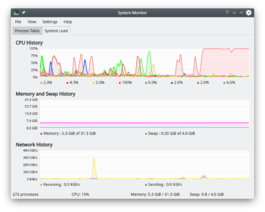 |
追踪控制系统进程. |
概述
系统监视器(KSysGuard),即KDE 系统监视器,设计简单,无需特别设置即可进行简单的进程控制 - 通常默认设置就够用了。它包含两张工作表 - (上面是图表)和。
系统负载
屏有3个显示图表,每个分别描绘如下负载要素 - 「CPU历史」,「内存和交换文件空间历史」,「网络历史」。如果你悬停鼠标指针到每个部分的,你会看到带有颜色的详细分析。
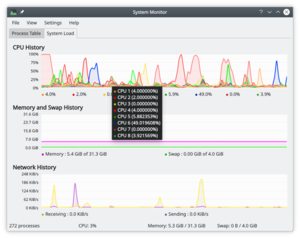 |
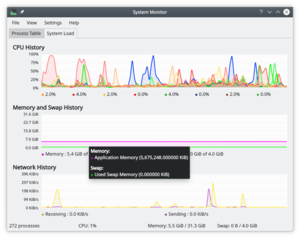 |
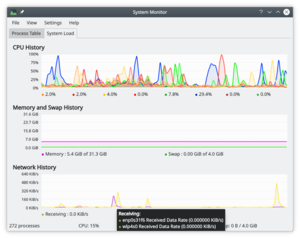 |
进程表
默认的视图会给你一份按照字母排序的所有运行的程序列表。点击任何列的标题会以此列排序。如果你有一个runaway进程(这种进程陷入无限循环,不停派生出子进程),你会发现视图最有用。你也能选择用「拥有者」或「程序」查看进程的子集。
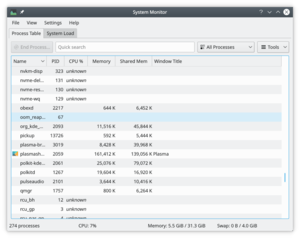 |
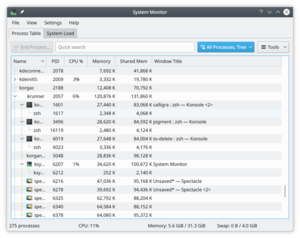 |
提示和技巧
Ctrl+Esc 能启动系统监视器的进程模块,通常在你想找出哪个程序占用太多资源的时候非常有用。
在 KRunner (Alt-F2 或是右击桌面) 上位于输入框左侧有个小图标-它看起来像微波炉-也能启动进程表。
